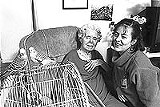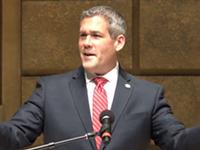[
{
"name": "500x250 Ad",
"insertPoint": "5",
"component": "15667920",
"parentWrapperClass": "",
"requiredCountToDisplay": "1"
}
]
As US battleships prepare to set sail again, another iceberg floats into harbor with hardly a PT boat deployed against it.
This 'berg is a troubling financial downturn among nursing homes, mostly connected to Medicaid reimbursements. (Medicaid, created in 1965 to provide health care for the poor, wasn't designed to pay for long-term care. But many people --- including a large middle-class population who aren't covered by Supplemental Security Income and the like, and who want to keep their estates intact --- have come to depend on it.)
As City Newspaper's Susan Herman detailed last week, the phenomenon has struck one local nursing home, the Wesley Community, especially hard. Last year, said Herman, Wesley posted nearly a $2 million deficit on a $17-million operating budget. A few years ago, she said, 20 percent of Wesley residents relied on Medicaid to pay the bills, while 80 percent relied on private means. Today the proportions are reversed, and since Medicaid pays less than the true costs of care, more deficits lie dead ahead.
Individual nursing homes have different profiles: their capital investments (buildings and grounds), stock holdings, endowments, and so forth. But all are growing closer together as the financial pinch tightens.
Take Fairport Baptist Homes, which has been riding out choppy waters in recent years. According to its official IRS filings, Fairport Baptist suffered nearly a $4 million deficit in 2000, compared to expenditures of just under $17 million. Development director Nick Jones says the deficit was linked to capital projects --- new buildings and upgrades --- from 1997 through 1999. Today, says Jones, "we're running a deficit, but it's the kind we can live with." He says a "rebasing" or slight increase in Medicaid payments has improved the outlook. But he adds Fairport Baptist, like other homes, must sometimes dip into the endowment, too.
Then there's "restructuring." A recent Fairport Baptist Homes newsletter, calling 2001 "a year of solidifying and strengthening," says the facility saved $350,000 by this means. An example: the cutting of the "LifeTimes" adult day-care program, which was said to be operating at only 30 percent capacity.
Jones says all the local faith-based nursing homes --- including the Episcopal Church Home, St. Ann's Community, the Jewish Home, and others --- are pretty much in the same boat. They've all had to "diversify," he says, by adding programs that can bring in money. For example, says Jones, some homes have provided child-care on-site.
But the range includes more than human services, per se. "We take in laundry" from outside, says Jones of one Fairport Baptist function that seems to surprise even him.
What goes for the region goes for the state, too.
"In 2000, using the most recent data, 46 percent of not-for-profit nursing homes statewide lost money, [as did] 30 percent of for-profits and 90 percent of public facilities," says Carl Young, president of the Albany-based New York Association of Homes and Services for the Aging (NYAHSA).
"The Rochester picture is not atypical," says Young, reflecting on the Wesley story.
"Medicaid has been an inadequate payer for some time," says Young. The reimbursement formula, he says, is the culprit. "Most facilities are tied to a 1983 base year," he says, explaining that yearly increases haven't kept pace with the actual rate of inflation.
As elsewhere in the health sector, prescription drugs are an important element. In 1983, says Young, nursing homes spent $1.50 per day per patient on prescription drugs; this, he says, was manageable. But now, he says, the homes must spend $9.50 per day --- on a $3.50 per day Medicaid drug reimbursement.
A recent article in McKnight's Long-Term Care News fleshed out this part of the story: "Medicaid spending rose overall by 11 percent in 2001, but prescription drug costs have been rising by more than 20 percent [annually]; at the same time, the recession has driven down state revenues --- and added many more poor and uninsured to the rolls."
The trend has been accelerating. Young says 1997 and 1998 "were pretty good years" for New York nursing homes, because of a "demo project" that boosted Medicare (as opposed to Medicaid) rates. But overall, things have been sliding. The state, says Young, suffered $2 billion in Medicaid cuts over the last decade.
Young's group, which represents more than 300 not-for-profit and publicly-operated facilities statewide, put out a report in February 2002 that underscores the Medicaid connection. Medicaid, says Tough Financial Times in New York's Nursing Homes, provides 70 percent of "net patient revenues." Additional reductions and other costs, says the report, will create a "liquidity crisis" that could doom many facilities.
The report, which surveyed 533 nursing homes statewide, highlights a crucial factor: a nursing home's ever-slender operating margin. In 1998, says the report, the average nursing home in New York had a 0.8 percent operating surplus; by 2000, that had fallen to a 0.9 percent deficit.
Coupled with this trend is the question of labor costs and working conditions. Like other health institutions, nursing homes are notorious for paying low wages for what are usually messy and difficult tasks. The work is tough on higher-paid workers like registered nurses, too. A recent report from AFSCME (American Federation of State, County, and Municipal Employees), using 1999 data, looks at conditions for "direct-care workers," including home health aides as well as nursing home staff. "Unfortunately," says the report, "our nation is so far from valuing direct-care workers that we pay them, on average, a median wage of just $7.97 per hour --- one-third less than the median wage of all workers in the United States at $11.87 per hour, as calculated by the Economic Policy Institute."
"Facilities," concludes Tough Financial Times, "are struggling to recruit and retain professional and paraprofessional workers amidst severe labor shortages." Labor costs, says the report, account for "70 to 80 percent of the average nursing home's expenses." A vicious cycle rules, according to the report: Granting raises, paying for overtime, the hiring of new staff (often temps), and similar factors cause "tremendous pressure on facility budgets."
But without raises, and so forth, workers move on, leaving facilities understaffed or dependent on newcomers with less expertise --- the recipe for a decline in safety and quality of care, followed by citations and other regulatory penalties.
Some advocates would ease the pressures by selling more people on the need to buy private long-term-care insurance.
One such advocate, the American Health Care Association, says "long-term care is clearly the number-one risk facing elderly Americans, and it's the one for which Americans are least insured." The Association wants Congress to encourage the purchase of long-term-care policies and "to help educate Americans" about costs, risks, and benefits.
NYAHSA's Carl Young says the government should provide tax incentives for buying private insurance. He feels, too, that something must be done to address "an ongoing injustice: lawyers showing people how to shelter their assets" so they can qualify for Medicaid.
"We're the richest country in the universe," Young says, "but we haven't figured out a way to fund essentials" like long-term care.
Demographic studies indicate that the need can only get greater.
"The fastest-growing part of the population is 85-plus," says Fran Weisberg, president of LIFESPAN, a local agency that serves caregivers as well as seniors.
Yet the US, says Weisberg, has no "integrated policy" on funding long-term care. "Until we have such a policy," she says, "we'll be in this bind."
Weisberg points out some peculiar contradictions. For example, she says, existing health insurance will cover heart attacks and other sudden illnesses, but it won't cover the needs of people suffering from dementia or the lingering effects of a stroke.
What's needed exactly? A "comprehensive" approach, says Weisberg. "We have to look at Medicare covering [long-term care], at sharing the burden nationally," she says. Otherwise, she says, "what's going to happen is that nursing homes will take only private-pay."
And that suggests a lot of bodies left out in the cold.
Speaking of Nursing Homes
Latest in News
More by Jack Bradigan Spula
-

The state of Main
Apr 14, 2004 -
School improvement: the price is wrought
Apr 7, 2004 -
Hour of power
Mar 31, 2004 - More »









